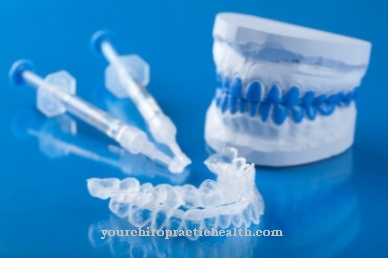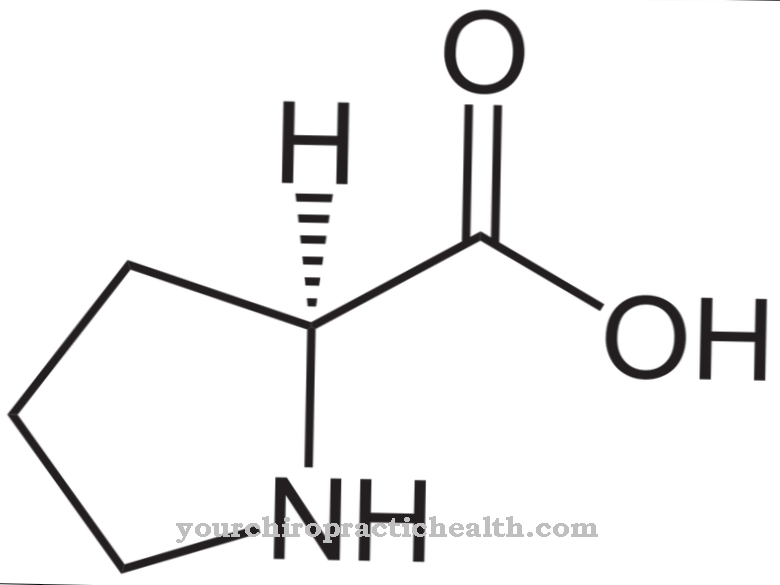In dentistry it is Compomer used as a filling material to fill cavities (the "hole" in the tooth). Compomers are among the modern plastic fillings and are an alternative to the classic amalgam fillings. They are usually used for minor defects or temporarily.
What is compomer?

Compomers were developed in the mid-1990s to complement common fillings such as amalgam or cement. Above all, the filler was supposed to be an alternative to the plastic resins used at the time, which were not considered to be particularly durable and long-lasting and which had compatibility risks.
The name "Kompomer" is a word created by the first manufacturer and goes back to the composition of the material. Compomers are made from two materials that can also be used individually as filling material for teeth: KOMPOsit and GlasionoMERzement.
Composite is a mixture of plastic and inorganic substances such as silica or glass particles, glass ionomer cement consists of glass and quartz particles. Composite fillings are considered stable and also aesthetic, as they can be adapted to the individual color of the tooth using coloring techniques. Glasinomer cement has a high adhesive capacity and bonds with the tooth substance through chemical reactions. Glasinomer cements also contain fluoride, which is slowly released to the tooth over the duration of the filling. This prevents new caries from developing around the edges of the filling and keeps the tooth healthy.
Shapes, types & types
Both composite and glasinomer cement have a high degree of transparency and are very similar to the tooth color or can be adjusted in color accordingly. That is why they are often used on the front teeth or other visible areas, for example.
Compomer, in its combination of both materials, should combine the advantages of composite and glasinomer cement and at the same time compensate for various disadvantages of these materials. For example, compomers can be processed more quickly and easily on the tooth than composite, which has to be pretreated by the dentist and used with a more complex layering technique. The composite gives compomers stability, abrasion resistance and surface hardness. However, when combined with Glasinomer cement, which is less durable and firm, these good properties are somewhat reduced.
Compomers, like composite, are not noticeable due to the possibility of optical adaptation to the tooth substance. Similar to glasinomer cement, they also adhere well to the tooth substance without prior treatment. Compomers also release fluoride to the tooth, but to a lesser extent than glasinomer cement and over a significantly shorter period of a few weeks.
Structure & functionality
To fill in compomers, the dentist drills out the diseased tooth substance as gently as possible. Then the tooth is prepared with the so-called adhesive, a light-curing special plastic adhesive. This adhesive is necessary to improve the adaptation of the compomers to the hard tooth substance (due to the composite components, the material does not adhere as well as a glass-inomer cement).
Then the compomer is filled or layered directly into the prepared cavity using a dosing syringe. The layering technique is a little less complicated than with the composites. It must be used for slightly deeper holes in the tooth to ensure good stability. The material hardens directly in the mouth with a special cold light or with the help of UV light. In the layering technique, each layer must be cured individually.
During the curing process, compomers can show slight material shrinkage. This creates the risk of so-called marginal gaps between the tooth substance and the filling. This can cause tooth decay on the edges of the filling. The dentist must take this into account and correct it accordingly when filling, because the fluoride release of the material can only prevent the development of caries to a limited extent. After hardening, the dentist works out the filling according to the anatomical conditions of the tooth. In the last step, the material is smoothed and polished.
You can find your medication here
➔ Medicines against tartar and tooth discolorationMedical & health benefits
Compomer fillings are more suitable for smaller fillings without great chewing pressure due to their somewhat lower abrasion hardness. The better biocompatibility of the compomers (compared to the mercury pollution of the amalgam) also proves to be an advantage. Allergies to components of the compomers or the adhesive are very rare.
Due to the adaptability of the color, compomers are particularly suitable for tooth fillings in the visible area, such as the neck of the tooth. Compomers, however, in contrast to composites, which are also used for this purpose, may absorb water. This can lead to unsightly discoloration of the margins in the anterior region.
Compomers are also used in temporary fillings in order to keep a tooth functional, for example after a root canal treatment, until it is finally restored (for example with an inlay).
The statutory health insurance companies cover the costs of compomers for the treatment of anterior tooth defects and for fillings in the tooth neck area. For fillings of milk teeth, the costs will be covered proportionally.












.jpg)






.jpg)

.jpg)




.jpg)

